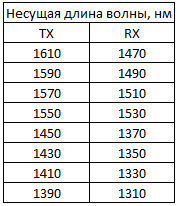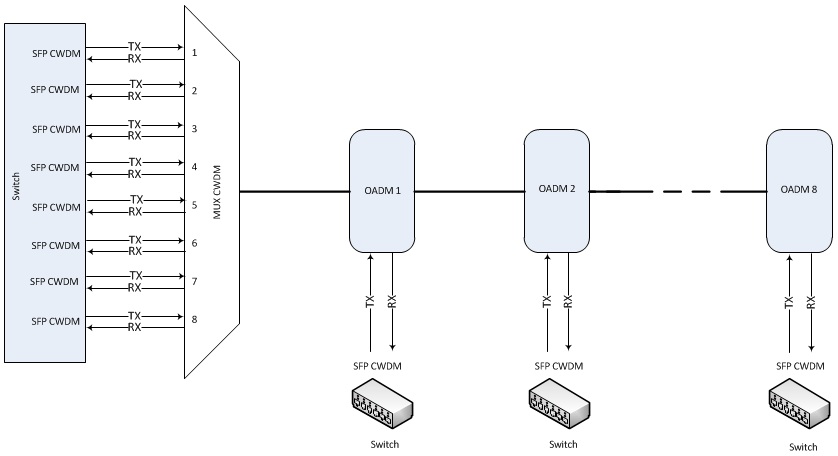CWDM - spectral multiplexing of optical channels
Introduction
I work in a small, by the standards of our city, an Internet company. In the past 5 years, our optical network has grown by leaps and bounds. Initially, the network topology was chosen incorrectly, namely the bus topology. As a result, if a failure occurred at an intermediate communication center (long-term power outage, equipment hang, etc.), then it affected all communication nodes located further. The obvious solution to this problem was to rebuild the network in accordance with the logical star topology. For this, it was required to connect each communication node with a separate fiber. But another problem surfaced, the number of free fibers was catastrophically low. Laying a new fiber optic link from the main communication nodes is financially expensive. The way out of this situation was the introduction of CWDM.
CWDM
CWDM (Coarse Wavelength Division Multiplexing) - multiplexing with sparse spectral separation. In other words, it is a technology that allows you to simultaneously transmit several information channels over a single optical fiber at different carrier frequencies. The CWDM wavelength grid is in the range from 1271 nm to 1611 nm with a step of 20 nm.
The principle of operation of CWDM is simple. Each transceiver module generates a signal at a specific frequency. Before you get into the optical fiber, the signal from the modules is integrated by the multiplexer and transmitted to the fiber. At the receiving end, the signal is separated by a demultiplexer. In order for the optical network from the bus topology to be transformed into a star topology, the demultiplexer must not only receive the signal at a given length, but also pass the signal further without changing it. For this, we used OADM.
Oadm
OADM (Optical Add Drop Multiplexor) is a CWDM optical I / O multiplexer system that extracts a signal at a given wavelength from an optical line, and passes all other radiation unchanged.
The OADM module has four interfaces:
Com - receives a signal from the multiplexer
Express - passes the signal further
Add - incoming line at a specific wavelength
Drop - outgoing line at a specific wavelength
SFP
SFP (Small Form Factor Pluggable ) Transceivers are the industry standard for modular compact transceivers used for data transmission. Each SFP CWDM transceiver operates on two fibers, at two different wavelengths — a receiver at one wavelength and a transmitter over the other.
')
Practical implementation
In practice, we used a multiplexer (MUX) with 8 channels, SFP transceiver transceivers, and OADM modules. Used wavelengths are presented in the table.

Below is the implemented scheme.

Conclusion
Problems
When implementing CWDM, we encountered some problems. At each node, optical cross-connects are terminated with SC connectors. SFP modules have LC connectors. When ordering OADM modules, an error was made; OADM modules were ordered with LC connectors. When introducing CWDM, we had to use a bunch of patch cords, LC and SC sockets, which gave not weak attenuation to the optical communication line, in consequence of which, SFP-modules on remote nodes refused to work. Plus OADM modules introduce attenuation from 0.8 to 1.2 dB. The decision was, the rejection of transitional patch breeds, and sockets. Optical crosses were digested to LC connectors.
Benefits
- The CWDM system is power independent. Power is needed only for active equipment. What in our case we wanted to achieve. When the node falls, the remaining nodes work
- Increased traffic up to 8 times per fiber
- Possibility of mounting OADM modules in various places (in crosses, couplings, etc.)
- The introduction of the CWDM system is cheaper than laying new optical lines over long distances
Source: https://habr.com/ru/post/113314/
All Articles